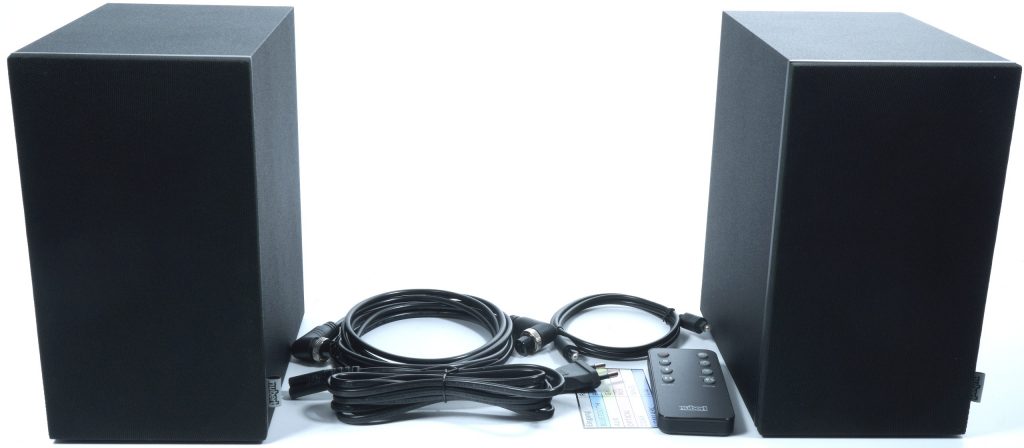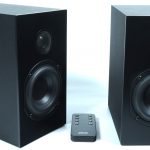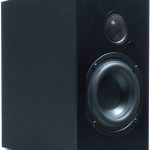 Smaller, lighter, cheaper and still better in many areas? Names are sound and smoke, at least for some vendors who, with cheaper product lines, only eat from the glory of days gone by. Klipsch's active boxes are by no means a bad cheap drop, but both the louse quality of the folding and the boards, as well as the annoying background noise, have made me look for alternatives for the desktop time and again. Keep. Of course, you can't really compare the output power of both pairs of boxes, but on the desktop I quickly realized that even a little less is completely sufficient.
Smaller, lighter, cheaper and still better in many areas? Names are sound and smoke, at least for some vendors who, with cheaper product lines, only eat from the glory of days gone by. Klipsch's active boxes are by no means a bad cheap drop, but both the louse quality of the folding and the boards, as well as the annoying background noise, have made me look for alternatives for the desktop time and again. Keep. Of course, you can't really compare the output power of both pairs of boxes, but on the desktop I quickly realized that even a little less is completely sufficient.
The NUBOX A-125 from Nubert actually came to me just right and also in exciting black. There is also fashionable anthracite, but it's not really mine. Speaking of names, sound and corresponding smoke – the Swabian supplier of the slightly different loudspeakers has not only remained down-to-earth (and thus also in Germany), but sells all the nice things in the significantly cheaper direct sales, the kind of extravaganzas of a German production in the first place makes it affordable. One also sees oneself as a provider of "honest" loudspeakers, which for more than four decades have been oriented towards the technically possible and less on the current mainstream. Of course you have to like it, but there are reasons that you can hear. This is a point of contrast to Klipsch and the product production that has since been whipped up in the Far East.
By the way, I didn't really trust the matter at first because of the size, but try makes wise and at the end of a month you are then at least one knowledge richer (and possibly. a few euros poorer). And for those who now say that you don't have to spend 385 euros to get smart sound on the desktop: right, you don't really have to, but you can (and should) if it's more than just a game or Spotify for the audio pacifier in between. I work with it, too. But not only and Bluetooth is a must.
At the latest in the video editing, a pair of neat monitors in the near field is of greater importance. The that then also the breaks can be filled acoustically, I book under bonus. When working, the subwoofer is usually switched off under the table, but when playing and listening to music, it is then allowed to diligently cement the bass foundation underground. Without it, it simply cannot be done, because the respective volume of these boxes make below approx. 50 Hz the pleasure quickly puts an end to it. A rather potent but space-saving Nubert AW-350 has been used for this purpose for a long time, even if the beloved small furniture is now unfortunately EOL.
Scope of delivery and unboxing
There are no surprises, because you get a pair of boxes (the right box is the active one), the two-pole power connection cable, an optical cable, a well-in-the-hand IR remote control with the most important functions, manual and a proprietary Speaker connection cable that is reminiscent of an XLR cable with a nut, but is not one. If the supplied 3 meters are not enough, the 4 wires can either re-solder themselves or choose from longer cables up to 7 meters in the Nubert shop. I will deal with the front panels that were also supplied later.
Optics, haptics and features
The boxes are made of very cleanly foiled, medium-density MDF and differ significantly from the Clipsch boxes in terms of processing quality (especially at the edges). The active box weighs approx. 3.7 kilos, the passive 3.3 kilos. The boxes are 24.5 cm high, 13.5 cm wide and 20 cm deep. The front panels with textile covering and another centimetre for the depth are also available as a flush, whereby the magnets have been placed so smartly that the aperture is positioned by itself and absolutely precisely. By the way, the complete front is designed as a mounted aperture made of MDF with sanding varnish, in which the counterparts of the magnets are also left invisible from behind.
In the front, screwed from the outside, sits a 118 mm deep/midrange driver with polypropylene composite membrane (4 ohms, 25 watts) and relatively long stroke. Above, behind bars, a 25 mm tissue calotte (8 ohms, 15 watts) embedded in the MDF plays as a tweeter. There is no passive switch, the DSP chip actively does this before the separate Class-D power amplifiers for medium/low tone and high tone. This is then also explained by the proprietary loudspeaker cable to the left, passive box The frequency response (3 dB) is stated by the manufacturer with 50 – 20 000 Hz, whereby the amplifier circuit has a soft clipping function for protection and with the subwoofer connected still a Low-cut from approx. 80 Hz attacks so as not to waste output power into inaudible frequencies unnecessarily.
Nubert gives the rated power of 2 x 25 watts, with the majority being accounted for by the medium/low-tone channel. The music performance of 2 x 40 watts is more marketing, because what really counts is on the pitch. This can even be measured and yes, the nominal performance is pleasingly accurate. The power consumption of less than 0.5 W in standby also eliminates the need for a physical power switch on the back, which I will come to in a moment. In the front of the active loudspeaker is still the IR receiver for the remote control with status LED, which is still visible due to the textile covering.
Connectivity is quite extensive, even if a USB port is missing. There is a stereo RCA pair (300 mV input sensitivity), S/PDIF or Toslink, HDMI-ARC and the built-in Bluetooth receiver with AptX support (Bluetooth 4.2). Optionally, there is a sub-out and link. This is completely sufficient to connect the most common devices and use them as a variab source. The switching takes place exclusively on the remote control, as well as the volume control with mute function and the usual DSP sound games such as presets for music playback and movie, whereby behind this function a quite nicely functioning stereo base widening.
For closely related boxes, this works quite neatly with movies and gaming, only the music becomes very medium and high-altitude, almost shrill. Sound controllers in the classical sense, however, are not found, the boxes are rather neutrally tuned towards a light bathtub. You can actually live with this quite well even without AnEQ.
Setting up tips
But then I still have a little hint, because the two boxes only have four small rubber feet for setting up. If the distance to the table top seems too small for acoustic decoupling, you are welcome to rely on such soft rubber feet as in the picture below. They have really proven themselves for years and cost only a narrow thaler.
In addition, the boxes should be set up slightly angled on the desktop, as the tweeters do not have any really wide opening angles. You don't have to align the boxes completely on yourself, but a little bit helps. Then it works again with the clean super high tone.
At the time, the horns of the Klipsch boxes were much more variable and, above all, more generous in terms of orientation.
The bass reflex opening is located on the back and the distance to the wall should be calculated to 10 cm or more if possible. In contrast to the R-15PM, these influences of the NUBOX A-125 were still quite small.
| Assembly: | 1 x tweeter with 25 mm fabric calotte 1 x 118 mm woofer with polypropylene composite membrane |
| Frequency response (x3 dB): | 50 – 20 000 Hz |
| Hedge: | Soft clipping function |
| Rating: | 2 x 25 watts |
| Music performance: | 2 x 40 watts |
| Standby Power Consumption: | < 0,5 W 0,5=""></ 0,5 W> |
| Input sensitivity: | 300 mV |
| Connections: | Stereocinch, S/PDIF, Toslink, HDMI-ARC, Sub-Out, Link, Bluetooth receiver with AptX support (Bluetooth 4.2) |
| Max. Input: | 3.5V |
| Total dimensions: | H: 24.5 cm W: 13.5 cm D: 20 / 21 cm (without / with front cover) |
| Versions: | Graphite, fabric cover grey mottled/black, fabric cover black |
| Weight: | Master 3.7 kg / Slave 3.3 kg |
| Packaging: | 41 x 31 x 37.5 cm (packaged in pairs) |
| Manufacturer/Product Link: |
https://www.nubert.de/nubox-a-125/p3776/ |




























 7
7





















Kommentieren